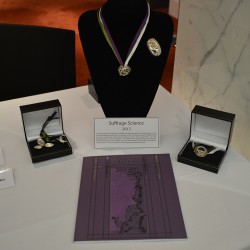
Is science pale, male and stale? Have we come a long way? Much has changed in the world of science since Marjory Stephenson and Kathleen Lonsdale became the first female Fellows of the Royal Society in 1945 – but is the situation for today’s women scientists better, worse or the same?
We invited the audience to reflect on the issue of women in science at our annual Suffrage Science event on Sunday, hosted for the first time at the Royal Society in London.
Suffrage Science is organised annually on International Women’s Day (8th March) to commemorate, promote and unite women across science and engineering. It is centred on the passing on of jewellery from one generation of leading women scientists to the next. The heirlooms, handcrafted and designed by Central Saint Martins College of Art and Design, were inspired by the jewellery awarded to women of the Suffrage movement in recognition of their campaign for equal voting rights. This year, 12 women scientists from engineering, physics, and biomedicine received their jewellery pieces from Mandy Fisher, director of the CSC, and Vivienne Parry, science journalist and BBC broadcaster, who conceived of the science heirlooms.
The energetic science communicator Kat Arney led us through the evening, which kicked off with short presentations of the lives of Marjory Stephenson and Kathleen Lonsdale by researcher Jane Cope and writer Georgina Ferry. Carol Dyehouse, a social historian from Brighton, introduced some of the history of women in education, inquiring what held them back. An inspiring discussion followed the actual award ceremony. The majority of the audience felt that the situation for women scientists has much improved. Equality legislation protects women in the workplace, girls face a more equal, less gendered education, and grow up with an increasing number of female role models. However, childcare costs are high, maternity leave is lopsided in that it does not include fathers, and girls’ – and women’s – confidence still needs boosting. Some felt the situation had simply not changed much compared with 1945 – “The gender balance in upper management of universities is still very pale, male, and stale” – and that we needed to also focus on class and racial discrimination. One member, who considered the situation to be worse, said, “We are now educated on an equal basis at school and university but still do not have equal opportunities in science – this somehow makes things even worse!” The predominant feeling was that women should not copy men but go out confidently and spread their enthusiasm for science. Society should seek to support individuals and to break down stereotypes – as one audience member put it: “Let people be people and science be science!”
This year’s Science Suffragettes are:
Lucie Green (Space Scientist, UCL)
Lorna Dougan (Physicist, Leeds)
Anne Vanhoestenberghe (Engineer, UCL)
Susan Condor (Social Psychologist, Loughborough)
Anne Neville (Engineer, Leeds)
Ruth Wilcox (Engineer, Leeds)
Anna Goodman (Population Health Scientist, LSHTM)
Silvia Munoz Descalzo (Stem Cell Scientist, Bath)
Patricia Bassereau (Biophysicist, Curie Institute, Paris)
Alicia El Haj (Bioengineering, Keele)
Tamsin Edwards (Geographical Sciences, Bristol)
Polly Arnold (Chemistry, Edinburgh)
In 2017, the heirlooms will be passed on again in a bid to encourage more women to pursue leadership roles in the engineering sciences.
